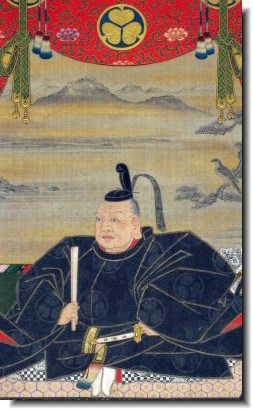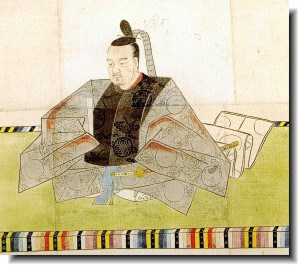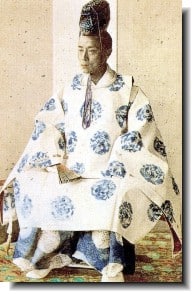 Ieyasu (1543-1616), the first shogun. A great warrior, he defeated his rival warlords at the Battle of Sekigahara in 1600 and brought all Japan under his rule. Credited with bringing peace, unity and stability, he made Edo his capital, built Edo Castle and developed the city. He employed the British seafarer William Adams to build ships and establish trading links with the west. (Adams’s story inspired the novel Shogun.) Had 2 wives and 17 concubines who bore him 11 sons and 5 daughters. Died in his bed of cancer or syphilis aged 75.
Ieyasu (1543-1616), the first shogun. A great warrior, he defeated his rival warlords at the Battle of Sekigahara in 1600 and brought all Japan under his rule. Credited with bringing peace, unity and stability, he made Edo his capital, built Edo Castle and developed the city. He employed the British seafarer William Adams to build ships and establish trading links with the west. (Adams’s story inspired the novel Shogun.) Had 2 wives and 17 concubines who bore him 11 sons and 5 daughters. Died in his bed of cancer or syphilis aged 75.
Iemitsu (1604-1651), the third shogun. Suspecting (with good reason) the Portuguese missionaries of being troublemakers, Iemitsu threw them out, banned Christianity and closed the country to all foreigners other than a handful of Dutch and Chinese traders. Greatly under the influence of his wet nurse, Lady Kasuga, who established the women’s palace and laid out the rules.
Tsunayoshi (1646-1709), the fifth shogun. Nicknamed the Dog Shogun, he was born in the Year of the Dog and passed laws protecting dogs and establishing kennels. The Dutch doctor Engelbert Kaempfer visited Edo Castle in 1691 and glimpsed the face of His Majesty’s wife – ‘of beautiful shape, with black European eyes, full of fire and vigour’. Died in his bed aged 62.
Ienobu (1662-1712), the sixth shogun. Had at least five concubines, including Gekko’in, deadly rival of his wife Hiroko. Gekko’in’s favourite was Ejima. Died in his bed aged 51.
Ietsugu (1709-1716), the seventh shogun. Came to power aged 4, died aged 7.
Yoshimune (1684-1751), the eighth shogun. One of the greatest rulers of Japan, he carried out sweeping financial reforms. Relaxed the ban on foreign books, resulting in the development of Western Studies. Famous for mixing incognito with commoners.
 Ienari (1773-1841), the eleventh shogun. Presided over a period of pleasure, excess and corruption. His women’s palace was home to 53 children. His wife, 27 concubines and the many other women who lived there enjoyed lives of enormous luxury. Was said to be riddled with syphilis. Died in his bed aged 68.
Ienari (1773-1841), the eleventh shogun. Presided over a period of pleasure, excess and corruption. His women’s palace was home to 53 children. His wife, 27 concubines and the many other women who lived there enjoyed lives of enormous luxury. Was said to be riddled with syphilis. Died in his bed aged 68.
Ieyoshi (1793-1853), the twelfth shogun. His wife, Princess Sachi, died aged 26 after several miscarriages. Had 15 concubines who bore him 27 children. In 1853, the American Commodore Matthew Perry arrived with his Black Ships, ordering Japan to open to trade and commerce with the west. Two weeks later, Ieyoshi died, cut down in the palace by his aides who considered him incapable of dealing with the foreign threat, according to Rutherford Alcock, head of the British Legation in Japan from 1859.
Iesada (1824-1858), the thirteenth shogun. An epileptic and mentally feeble, his first two wives died before he became shogun. His third wife, Princess Sumiko, outlived him and, as his widow, became Princess Kazu’s nemesis, Lady Tensho’in. Met the first American consul, Townsend Harris, and signed a treaty of friendship. Two weeks later, suddenly died suspiciously, aged 34. Three concubines but no children.
Iemochi (1846-1866), the fourteenth shogun. Came to the throne aged 12. Had an arranged marriage with Princess Kazu to try and bring together the shogun’s and emperor’s supporters. The first shogun for many generations to leave Edo, he made three visits to the emperor to try to make peace. Died under suspicious circumstances while away at war, aged 19. One concubine and no children.
 Yoshinobu (1837-1913), the fifteenth and last shogun. The British diplomat Ernest Satow described him as ‘one of the most aristocratic-looking Japanese I have ever seen, of high forehead and with a well-cut nose – such a gentleman.’ Famously brilliant and wily, he suspected that if Japan was swept into all-out civil war the foreign powers, having colonised India and China, would do the same to Japan. In 1867 made the decision to end the fighting by abdicating as shogun, thus ending the line of shoguns. Spent his last 45 years practicing photography and producing children. Ten boys and eleven girls survived to maturity. Died in his bed.
Yoshinobu (1837-1913), the fifteenth and last shogun. The British diplomat Ernest Satow described him as ‘one of the most aristocratic-looking Japanese I have ever seen, of high forehead and with a well-cut nose – such a gentleman.’ Famously brilliant and wily, he suspected that if Japan was swept into all-out civil war the foreign powers, having colonised India and China, would do the same to Japan. In 1867 made the decision to end the fighting by abdicating as shogun, thus ending the line of shoguns. Spent his last 45 years practicing photography and producing children. Ten boys and eleven girls survived to maturity. Died in his bed.
Comments are closed.